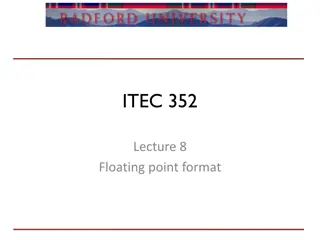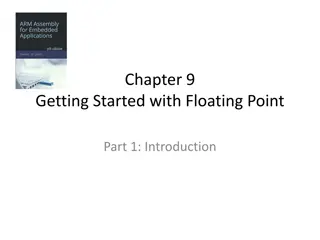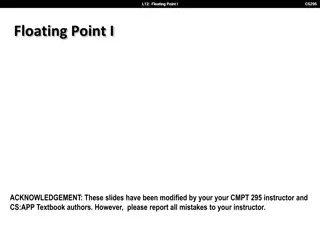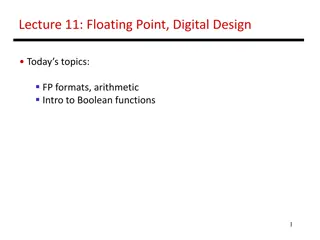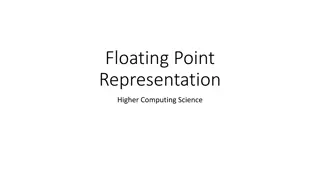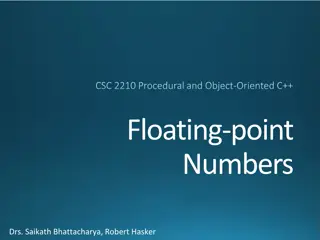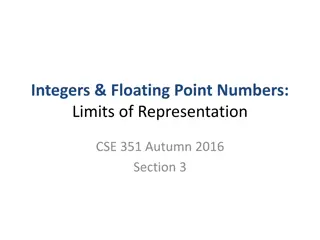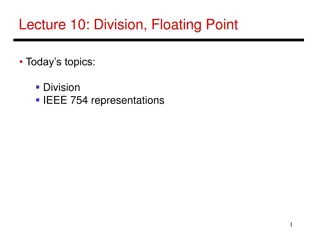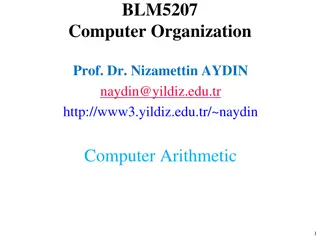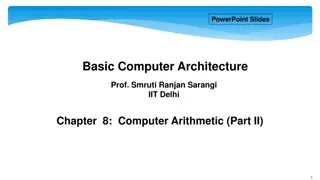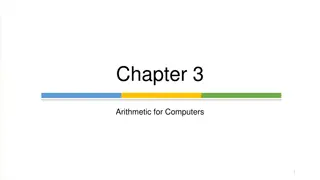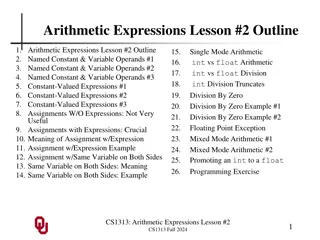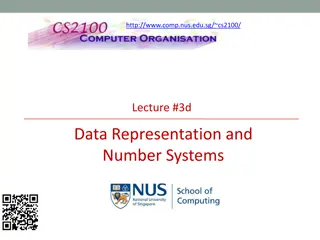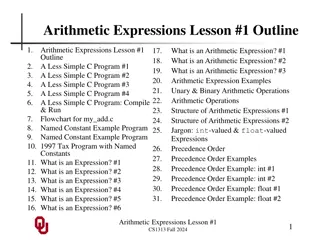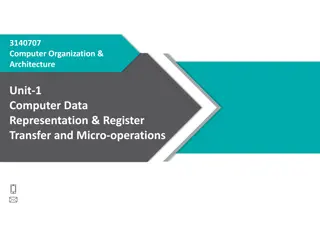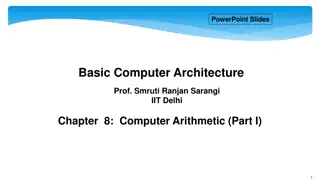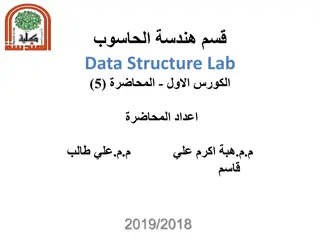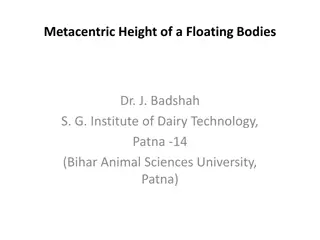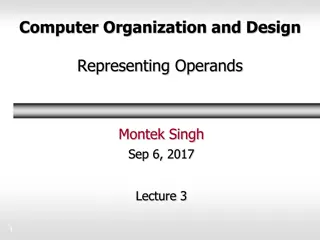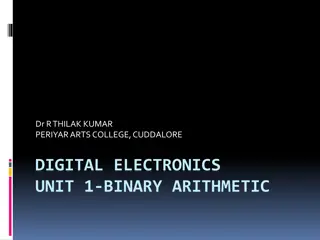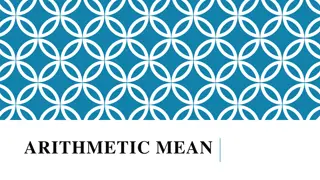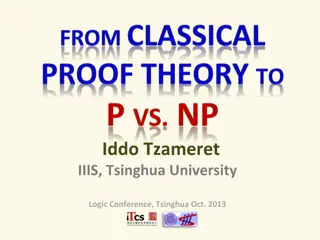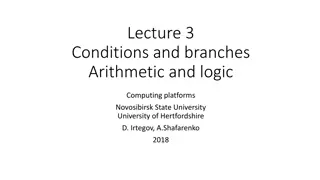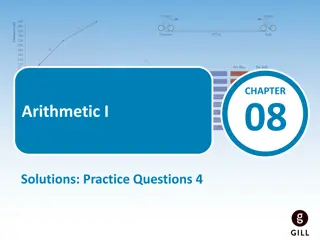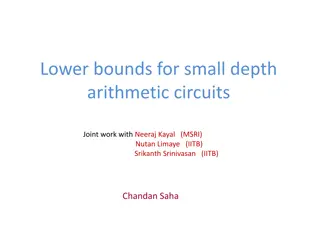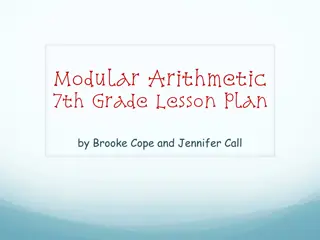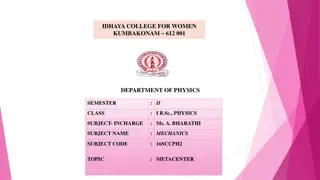Understanding Floating-Point Arithmetic in Computer Organization
Exploring floating-point numbers and their representation in the IEEE 754 standard, including addition, subtraction, multiplication, and rounding. Learn about the significance of extra bits, the importance of normalization, and the impact of precision on floating-point values. Delve into MIPS floating-point instructions for practical implementation in computer systems.
Download Presentation

Please find below an Image/Link to download the presentation.
The content on the website is provided AS IS for your information and personal use only. It may not be sold, licensed, or shared on other websites without obtaining consent from the author. Download presentation by click this link. If you encounter any issues during the download, it is possible that the publisher has removed the file from their server.
E N D
Presentation Transcript
Floating Point Arithmetic COE 301 Computer Organization Prof. Aiman El-Maleh College of Computer Sciences and Engineering King Fahd University of Petroleum and Minerals [Adapted from slides of Dr. M. Mudawar, COE 301, KFUPM]
Outline Floating-Point Numbers IEEE 754 Floating-Point Standard Floating-Point Addition and Subtraction Floating-Point Multiplication Extra Bits and Rounding MIPS Floating-Point Instructions Floating Point Arithmetic COE 301 KFUPM slide 2
The World is Not Just Integers Programming languages support numbers with fraction Called floating-point numbers Examples: 3.14159265 ( ) 2.71828 (e) 0.000000001 or 1.0 10 9(seconds in a nanosecond) 86,400,000,000,000 or 8.64 1013(nanoseconds in a day) last number is a large integer that cannot fit in a 32-bit integer We use a scientific notation to represent Very small numbers (e.g. 1.0 10 9) Very large numbers (e.g. 8.64 1013) Scientific notation: d.f1f2f3f4 10 e1e2e3 Floating Point Arithmetic COE 301 KFUPM slide 3
Floating-Point Numbers Examples of floating-point numbers in base 10 5.341 103, 0.05341 105, 2.013 10 1 , 201.3 10 3 Examples of floating-point numbers in base 2 1.00101 223, 0.0100101 225, 1.101101 2 3 , 1101.101 2 6 Exponents are kept in decimal for clarity The binary number (1101.101)2= 23+22+20+2 1+2 3= 13.625 Floating-point numbers should be normalized Exactly one non-zero digit should appear before the point In a decimal number, this digit can be from 1 to 9 In a binary number, this digit should be 1 Normalized FP Numbers: 5.341 103 and 1.101101 2 3 NOT Normalized: 0.05341 105and 1101.101 2 6 decimal point binary point Floating Point Arithmetic COE 301 KFUPM slide 4
Floating-Point Representation A floating-point number is represented by the triple S is the Sign bit (0 is positive and 1 is negative) Representation is called sign and magnitude E is the Exponent field (signed) Very large numbers have large positive exponents Very small close-to-zero numbers have negative exponents More bits in exponent field increases range of values F is the Fraction field (fraction after binary point) More bits in fraction field improves the precision of FP numbers S Exponent Fraction Value of a floating-point number = (-1)S val(F) 2val(E) Floating Point Arithmetic COE 301 KFUPM slide 5
Next . . . Floating-Point Numbers IEEE 754 Floating-Point Standard Floating-Point Addition and Subtraction Floating-Point Multiplication Extra Bits and Rounding MIPS Floating-Point Instructions Floating Point Arithmetic COE 301 KFUPM slide 6
IEEE 754 Floating-Point Standard Found in virtually every computer invented since 1980 Simplified porting of floating-point numbers Unified the development of floating-point algorithms Increased the accuracy of floating-point numbers Single Precision Floating Point Numbers (32 bits) 1-bit sign + 8-bit exponent + 23-bit fraction S Exponent8 Fraction23 Double Precision Floating Point Numbers (64 bits) 1-bit sign + 11-bit exponent + 52-bit fraction S Exponent11 Fraction52 (continued) Floating Point Arithmetic COE 301 KFUPM slide 7
Normalized Floating Point Numbers For a normalized floating point number (S, E, F) S E F = f1f2f3f4 Significand is equal to (1.F)2 = (1.f1f2f3f4 )2 IEEE 754 assumes hidden 1. (not stored) for normalized numbers Significand is 1 bit longer than fraction Value of a Normalized Floating Point Number is ( 1)S (1.F)2 2val(E) ( 1)S (1.f1f2f3f4 )2 2val(E) ( 1)S (1 + f1 2-1 + f2 2-2 + f3 2-3 + f4 2-4 )2 2val(E) ( 1)Sis 1 when S is 0 (positive), and 1 when S is 1 (negative) Floating Point Arithmetic COE 301 KFUPM slide 8
Biased Exponent Representation How to represent a signed exponent? Choices are Sign + magnitude representation for the exponent Two s complement representation Biased representation IEEE 754 uses biased representation for the exponent Value of exponent = val(E) = E Bias (Bias is a constant) Recall that exponent field is 8 bits for single precision E can be in the range 0 to 255 E = 0 and E = 255 are reserved for special use (discussed later) E = 1 to 254 are used for normalized floating point numbers Bias = 127 (half of 254), val(E) = E 127 val(E=1) = 126, val(E=127) = 0, val(E=254) = 127 Floating Point Arithmetic COE 301 KFUPM slide 9
Biased Exponent Contd For double precision, exponent field is 11 bits E can be in the range 0 to 2047 E = 0 and E = 2047 are reserved for special use E = 1 to 2046 are used for normalized floating point numbers Bias = 1023 (half of 2046), val(E) = E 1023 val(E=1) = 1022, val(E=1023) = 0, val(E=2046) = 1023 Value of a Normalized Floating Point Number is ( 1)S (1.F)2 2E Bias ( 1)S (1.f1f2f3f4 )2 2E Bias ( 1)S (1 + f1 2-1 + f2 2-2 + f3 2-3 + f4 2-4 )2 2E Bias Floating Point Arithmetic COE 301 KFUPM slide 10
Examples of Single Precision Float What is the decimal value of this Single Precision float? 10111110001000000000000000000000 Solution: Sign = 1 is negative Exponent = (01111100)2 = 124, E bias = 124 127 = 3 Significand = (1.0100 0)2 = 1 + 2-2 = 1.25 (1. is implicit) Value in decimal = 1.25 2 3 = 0.15625 What is the decimal value of? 01000001001001100000000000000000 Solution: implicit Value in decimal = +(1.01001100 0)2 2130 127 = (1.01001100 0)2 23 = (1010.01100 0)2 = 10.375 Floating Point Arithmetic COE 301 KFUPM slide 11
Examples of Double Precision Float What is the decimal value of this Double Precision float ? 01000000010100101010000000000000 00000000000000000000000000000000 Solution: Value of exponent = (10000000101)2 Bias = 1029 1023 = 6 Value of double float = (1.00101010 0)2 26 (1. is implicit) = (1001010.10 0)2 = 74.5 What is the decimal value of ? 10111111100010000000000000000000 00000000000000000000000000000000 Do it yourself! (answer should be 1.5 2 7 = 0.01171875) Floating Point Arithmetic COE 301 KFUPM slide 12
Converting FP Decimal to Binary Convert 0.8125 to binary in single and double precision Solution: Fraction bits can be obtained using multiplication by 2 0.8125 2 = 1.625 0.625 2 = 1.25 0.25 2 = 0.5 0.5 2 = 1.0 Stop when fractional part is 0 Fraction = (0.1101)2 = (1.101)2 2 1 (Normalized) Exponent = 1 + Bias = 126 (single precision) and 1022 (double) 0.8125 = (0.1101)2 = + + 1/16 = 13/16 Single Precision 10111111010100000000000000000000 10111111111010100000000000000000 Double Precision 00000000000000000000000000000000 Floating Point Arithmetic COE 301 KFUPM slide 13
Largest Normalized Float What is the Largest normalized float? Solution for Single Precision: 01111111011111111111111111111111 Exponent bias = 254 127 = 127 (largest exponent for SP) Significand = (1.111 1)2 = almost 2 Value in decimal 2 2127 2128 3.4028 1038 Solution for Double Precision: 01111111111011111111111111111111 11111111111111111111111111111111 Value in decimal 2 21023 21024 1.79769 10308 Overflow: exponent is too large to fit in the exponent field Floating Point Arithmetic COE 301 KFUPM slide 14
Smallest Normalized Float What is the smallest (in absolute value) normalized float? Solution for Single Precision: 00000000100000000000000000000000 Exponent bias = 1 127 = 126 (smallest exponent for SP) Significand = (1.000 0)2 = 1 Value in decimal = 1 2 126 = 1.17549 10 38 Solution for Double Precision: 00000000000100000000000000000000 00000000000000000000000000000000 Value in decimal = 1 2 1022 = 2.22507 10 308 Underflow: exponent is too small to fit in exponent field Floating Point Arithmetic COE 301 KFUPM slide 15
Zero, Infinity, and NaN Zero Exponent field E = 0 and fraction F = 0 +0 and 0 are possible according to sign bit S Infinity Infinity is a special value represented with maximum E and F = 0 For single precision with 8-bit exponent: maximum E = 255 For double precision with 11-bit exponent: maximum E = 2047 Infinity can result from overflow or division by zero + and are possible according to sign bit S NaN (Not a Number) NaN is a special value represented with maximum E and F 0 Result from exceptional situations, such as 0/0 or sqrt(negative) Operation on a NaN results is NaN: Op(X, NaN) = NaN Floating Point Arithmetic COE 301 KFUPM slide 16
Denormalized Numbers IEEE standard uses denormalized numbers to Fill the gap between 0 and the smallest normalized float Provide gradual underflow to zero Denormalized: exponent field E is 0 and fraction F 0 Implicit 1. before the fraction now becomes 0. (not normalized) Value of denormalized number ( S, 0, F ) Single precision: Double precision: ( 1)S (0.F)2 2 126 ( 1)S (0.F)2 2 1022 Negative Overflow Negative Underflow Positive Underflow Positive Overflow - + Normalized ( ve) Denorm Denorm Normalized (+ve) 0 -2128 -2 126 2 126 2128 Floating Point Arithmetic COE 301 KFUPM slide 17
Special Value Rules Operation n / x nonzero / 0 + 0 / 0 - / x 0 NaN op anything Result 0 (similar for - ) NaN NaN (similar for - ) NaN NaN NaN Floating Point Arithmetic COE 301 KFUPM slide 18
Floating-Point Comparison IEEE 754 floating point numbers are ordered Because exponent uses a biased representation Exponent value and its binary representation have same ordering Placing exponent before the fraction field orders the magnitude Larger exponent larger magnitude For equal exponents, Larger fraction larger magnitude 0 < (0.F)2 2Emin< (1.F)2 2E Bias < (Emin = 1 Bias) Because sign bit is most significant quick test of signed < Integer comparator can compare magnitudes X < Y X = Y X > Y Integer Magnitude Comparator X = (EX, FX) Y = (EY, FY) Floating Point Arithmetic COE 301 KFUPM slide 19
Summary of IEEE 754 Encoding Single-Precision Normalized Number Denormalized Number Zero Infinity NaN Exponent = 8 1 to 254 0 0 255 255 Fraction = 23 Anything nonzero 0 0 nonzero Value (1.F)2 2E 127 (0.F)2 2 126 0 NaN Double-Precision Normalized Number Denormalized Number Zero Infinity NaN Exponent = 11 1 to 2046 0 0 2047 2047 Fraction = 52 Anything nonzero 0 0 nonzero Value (1.F)2 2E 1023 (0.F)2 2 1022 0 NaN Floating Point Arithmetic COE 301 KFUPM slide 20
Simple 6-bit Floating Point Example 6-bit floating point representation S Exponent3 Fraction2 Sign bit is the most significant bit Next 3 bits are the exponent with a bias of 3 Last 2 bits are the fraction Same general form as IEEE Normalized, denormalized Representation of 0, infinity and NaN Value of normalized numbers ( 1)S (1.F)2 2E 3 Value of denormalized numbers ( 1)S (0.F)2 2 2 Floating Point Arithmetic COE 301 KFUPM slide 21
Values Related to Exponent Exp. exp E 2E 0 Denormalized or 0 000 2 - 1 001 2 - 2 010 1 - 3 1 011 0 Normalized 4 2 100 1 5 4 101 2 6 8 110 3 7 n/a 111 Inf or NaN Floating Point Arithmetic COE 301 KFUPM slide 22
Dynamic Range of Values s 0 0 0 0 0 0 0 0 0 0 0 0 exp 000 000 000 000 001 001 001 001 010 010 010 010 frac 00 01 10 11 00 01 10 11 00 01 10 11 E 2 - 2 - 2 - 2 - 2 - 2 - 2 - 2 - 1 - 1 - 1 - 1 - value 0 1/4*1/4=1/16 2/4*1/4=2/16 3/4*1/4=3/16 4/4*1/4=4/16=1/4=0.25 5/4*1/4=5/16 6/4*1/4=6/16 7/4*1/4=7/16 4/4*2/4=8/16=1/2=0.5 5/4*2/4=10/16 6/4*2/4=12/16=0.75 7/4*2/4=14/16 smallest denormalized largest denormalized smallest normalized Floating Point Arithmetic COE 301 KFUPM slide 23
Dynamic Range of Values s 0 0 0 0 0 0 0 0 0 0 0 0 exp 011 011 011 011 100 100 100 100 101 101 101 101 frac 00 01 10 11 00 01 10 11 00 01 10 11 E 0 0 0 0 1 1 1 1 2 2 2 2 value 4/4*4/4=16/16=1 5/4*4/4=20/16=1.25 6/4*4/4=24/16=1.5 7/4*4/4=28/16=1.75 4/4*8/4=32/16=2 5/4*8/4=40/16=2.5 6/4*8/4=48/16=3 7/4*8/4=56/16=3.5 4/4*16/4=64/16=4 5/4*16/4=80/16=5 6/4*16/4=96/16=6 7/4*16/4=112/16=7 Floating Point Arithmetic COE 301 KFUPM slide 24
Dynamic Range of Values s 0 0 0 0 0 0 0 0 exp 110 110 110 110 111 111 111 111 frac 00 01 10 11 00 01 10 11 E 3 3 3 3 value 4/4*32/4=128/16=8 5/4*32/4=160/16=10 6/4*32/4=192/16=12 7/4*32/4=224/16=14 NaN NaN NaN largest normalized Floating Point Arithmetic COE 301 KFUPM slide 25
Distribution of Values Floating Point Arithmetic COE 301 KFUPM slide 26
Next . . . Floating-Point Numbers IEEE 754 Floating-Point Standard Floating-Point Addition and Subtraction Floating-Point Multiplication Extra Bits and Rounding MIPS Floating-Point Instructions Floating Point Arithmetic COE 301 KFUPM slide 27
Floating Point Addition Example Consider adding: (1.111)2 2 1 + (1.011)2 2 3 For simplicity, we assume 4 bits of precision (or 3 bits of fraction) Cannot add significands Why? Because exponents are not equal How to make exponents equal? Shift the significand of the lesser exponent right until its exponent matches the larger number (1.011)2 2 3 = (0.1011)2 2 2 = (0.01011)2 2 1 Difference between the two exponents = 1 ( 3) = 2 So, shift right by 2 bits 1.111 0.01011 10.00111 + Now, add the significands: Carry Floating Point Arithmetic COE 301 KFUPM slide 28
Addition Example contd So, (1.111)2 2 1 + (1.011)2 2 3 = (10.00111)2 2 1 However, result (10.00111)2 2 1 is NOT normalized Normalize result: (10.00111)2 2 1 = (1.000111)2 20 In this example, we have a carry So, shift right by 1 bit and increment the exponent Round the significand to fit in appropriate number of bits We assumed 4 bits of precision or 3 bits of fraction Round to nearest: (1.000111)2 (1.001)2 Renormalize if rounding generates a carry Detect overflow / underflow If exponent becomes too large (overflow) or too small (underflow) 1.000 111 1 1.001 + Floating Point Arithmetic COE 301 KFUPM slide 29
Floating Point Subtraction Example Consider: (1.000)2 2 3 (1.000)2 22 We assume again: 4 bits of precision (or 3 bits of fraction) Shift significand of the lesser exponent right Difference between the two exponents = 2 ( 3) = 5 Shift right by 5 bits: (1.000)2 2 3 = (0.00001000)2 22 Convert subtraction into addition to 2's complement Sign + 0.00001 22 1.00000 22 2 s Complement Since result is negative, convert result from 2's complement to sign-magnitude 0 0.00001 22 1 1.00000 22 1 1.00001 22 2 s Complement 0.11111 22 Floating Point Arithmetic COE 301 KFUPM slide 30
Subtraction Example contd So, (1.000)2 2 3 (1.000)2 22 = 0.111112 22 Normalize result: 0.111112 22 = 1.11112 21 For subtraction, we can have leading zeros Count number z of leading zeros (in this case z = 1) Shift left and decrement exponent by z Round the significand to fit in appropriate number of bits We assumed 4 bits of precision or 3 bits of fraction Round to nearest: (1.1111)2 (10.000)2 Renormalize: rounding generated a carry 1.11112 21 10.0002 21 = 1.0002 22 Result would have been accurate if more fraction bits are used 1.1111 1 10.000 + Floating Point Arithmetic COE 301 KFUPM slide 31
Floating Point Addition / Subtraction Start Shift significand right by d = | EX EY| 1. Compare the exponents of the two numbers. Shift the smaller number to the right until its exponent would match the larger exponent. Add significands when signs of X and Y are identical, Subtract when different X Y becomes X + ( Y) 2. Add / Subtract the significands according to the sign bits. 3. Normalize the sum, either shifting right and incrementing the exponent or shifting left and decrementing the exponent Normalization shifts right by 1 if there is a carry, or shifts left by the number of leading zeros in the case of subtraction 4. Round the significand to the appropriate number of bits, and renormalize if rounding generates a carry yes Overflow or underflow? Rounding either truncates fraction, or adds a 1 to least significant fraction bit Exception no Done Floating Point Arithmetic COE 301 KFUPM slide 32
Floating Point Adder Block Diagram EX EY 1 FX 1 FY sign Exponent Subtractor 0 1 Swap d = | EX EY | Shift Right add / subtract SX Sign Significand Adder/Subtractor add/sub sign Computation SY max ( EX , EY ) c c Detect carry, or Count leading 0 s Shift Right / Left z z Inc / Dec Rounding Logic c FZ SZ EZ Floating Point Arithmetic COE 301 KFUPM slide 33
Next . . . Floating-Point Numbers IEEE 754 Floating-Point Standard Floating-Point Addition and Subtraction Floating-Point Multiplication Extra Bits and Rounding MIPS Floating-Point Instructions Floating Point Arithmetic COE 301 KFUPM slide 34
Floating Point Multiplication Example Consider multiplying: 1.0102 2 1 by 1.1102 2 2 As before, we assume 4 bits of precision (or 3 bits of fraction) Unlike addition, we add the exponents of the operands Result exponent value = ( 1) + ( 2) = 3 Using the biased representation: EZ = EX + EY Bias EX = ( 1) + 127 = 126 (Bias = 127 for SP) EY = ( 2) + 127 = 125 EZ = 126 + 125 127 = 124 (value = 3) Now, multiply the significands: 1.010 1.110 0000 1010 1010 1010 10001100 (1.010)2 (1.110)2 = (10.001100)2 3-bit fraction 3-bit fraction 6-bit fraction Floating Point Arithmetic COE 301 KFUPM slide 35
Multiplication Example contd Since sign SX SY, sign of product SZ = 1 (negative) So, 1.0102 2 1 1.1102 2 2 = 10. 0011002 2 3 However, result: 10. 0011002 2 3 is NOT normalized Normalize: 10. 0011002 2 3 = 1.00011002 2 2 Shift right by 1 bit and increment the exponent At most 1 bit can be shifted right Why? Round the significand to nearest: 1.00011002 1.0012 (3-bit fraction) Result 1. 0012 2 2 (normalized) Detect overflow / underflow No overflow / underflow because exponent is within range 1.000 1100 1 1.001 + Floating Point Arithmetic COE 301 KFUPM slide 36
Floating Point Multiplication Start Biased Exponent Addition EZ= EX + EY Bias 1. Add the biased exponents of the two numbers, subtracting the bias from the sum to get the new biased exponent Result sign SZ = SXxorSY can be computed independently 2. Multiply the significands. Set the result sign to positive if operands have same sign, and negative otherwise Since the operand significands 1.FX and 1.FYare 1 and < 2, their product is 1 and < 4. To normalize product, we need to shift right by 1 bit only and increment exponent 3. Normalize the product if necessary, shifting its significand right and incrementing the exponent 4. Round the significand to the appropriate number of bits, and renormalize if rounding generates a carry Rounding either truncates fraction, or adds a 1 to least significant fraction bit yes Overflow or underflow? Exception no Done Floating Point Arithmetic COE 301 KFUPM slide 37
Next . . . Floating-Point Numbers IEEE 754 Floating-Point Standard Floating-Point Addition and Subtraction Floating-Point Multiplication Extra Bits and Rounding MIPS Floating-Point Instructions Floating Point Arithmetic COE 301 KFUPM slide 38
Extra Bits to Maintain Precision Floating-point numbers are approximations for Real numbers that they cannot represent Infinite variety of real numbers exist between 1.0 and 2.0 However, exactly 223 fractions can be represented in SP, and Exactly 252 fractions can be represented in DP (double precision) Extra bits are generated in intermediate results when Shifting and adding/subtracting a p-bit significand Multiplying two p-bit significands (product can be 2p bits) But when packing result fraction, extra bits are discarded We only need few extra bits in an intermediate result Minimizing hardware but without compromising precision Floating Point Arithmetic COE 301 KFUPM slide 39
Alignment and Normalization Issues During alignment smaller exponent argument gets significand right shifted need for extra precision in the FPU the question is how much extra do you need? During normalization a left or right shift of the significand may occur During the rounding step extra internal precision bits get dropped Time to consider how many extra bits we need to do rounding properly to compensate for what happens during alignment and normalization Floating Point Arithmetic COE 301 KFUPM slide 40
Guard Bit When we shift bits to the right, those bits are lost. We may need to shift the result to the left for normalization. Keeping the bits shifted to the right will make the result more accurate when result is shifted to the left. Questions: Which operation will require shifting the result to the left? What is the maximum number of bits needed to be shifted left in the result? If the number of right shifts for alignment >1, then the maximum number of left shifts required for normalization is 1. Floating Point Arithmetic COE 301 KFUPM slide 41
For Effective Addition Result of Addition either normalized or generates 1 additional integer bit hence right shift of 1 need for f+1 bits extra bit called rounding bit is used for rounding the result Alignment throws a bunch of bits to the right need to know whether they were all 0 or not for proper rounding hence 1 more bit called the sticky bit sticky bit value is the OR of the discarded bits Floating Point Arithmetic COE 301 KFUPM slide 42
For Effective Subtraction There are 2 subcases if the difference in the two exponents is larger than 1 alignment produces a mantissa with more than 1 leading 0 hence result is either normalized or has one leading 0 in this case a left shift will be required in normalization an extra bit is needed for the fraction called the guard bit the difference of the two exponents is 0 or 1 in this case the result may have many more than 1 leading 0 but at most one nonzero bit was shifted during normalization hence only one additional bit is needed for the subtraction result Floating Point Arithmetic COE 301 KFUPM slide 43
Extra Bits Needed Three bits are added called Guard, Round, Sticky Reduce the hardware and still achieve accurate arithmetic As if result significand was computed exactly and rounded Internal Representation: Floating Point Arithmetic COE 301 KFUPM slide 44
Guard Bit Guard bit: guards against loss of a significant bit Only one guard bit is needed to maintain accuracy of result Shifted left (if needed) during normalization as last fraction bit Example on the need of a guard bit: 1.00000000101100010001101 25 1.00000000000000011011010 2-2(subtraction) 01.00000000101100010001101 25 00.00000010000000000000001 1011010 25(shift right 7 bits) Guard bit do not discard 0 1.00000000101100010001101 25 1 1.11111101111111111111110 0 100110 25 (2's complement) 0 0.11111110101100010001011 0 100110 25 (add significands) + 1.11111101011000100010110 1 001100 24 (normalized) Floating Point Arithmetic COE 301 KFUPM slide 45
Round and Sticky Bits Two extra bits are needed for rounding Rounding performed after normalizing a result significand Round bit: appears after the guard bit Sticky bit: appears after the round bit (OR of all additional bits) Consider the same example of previous slide: Guard bit 1.00000000101100010001101 25 1 1.11111101111111111111110 0 1 00110 25 (2's complement) OR-reduce 0 0.11111110101100010001011 0 1 1 25 (sum) + 1.11111101011000100010110 1 1 1 24 (normalized) Round bit Sticky bit Floating Point Arithmetic COE 301 KFUPM slide 46
If the three Extra Bits not Used 1.00000000101100010001101 25 1.00000000000000011011010 2-2(subtraction) 1.00000000101100010001101 25 0.00000010000000000000001 1011010 25(shift right 7 bits) 1.00000000101100010001101 25 1 1.11111101111111111111111 25 (2's complement) 0 0.11111110101100010001100 25 (add significands) + 1.11111101011000100011000 24 (normalized without GRS) + 1.11111101011000100010110 24 (normalized with GRS) + 1.11111101011000100010111 24 (With GRS after rounding) Floating Point Arithmetic COE 301 KFUPM slide 47
Four Rounding Modes Normalized result has the form: 1. f1f2 flgrs The guard bit g, round bit r and sticky bit s appear after the last fraction bit fl IEEE 754 standard specifies four modes of rounding Round to Nearest Even: default rounding mode Increment result if: g=1 and r or s= 1 or (g=1 and r s= 00 and fl= 1 ) Otherwise, truncate result significand to 1. f1f2 fl Round toward + : result is rounded up Increment result if sign is positive and g or r or s = 1 Round toward : result is rounded down Increment result if sign is negative and g or r or s = 1 Round toward 0: always truncate result Floating Point Arithmetic COE 301 KFUPM slide 48
Illustration of Rounding Modes Rounding modes illustrated with $ rounding Notes Round down: rounded result is close to but no greater than true result. Round up: rounded result is close to but no less than true result. Floating Point Arithmetic COE 301 KFUPM slide 49
Closer Look at Round to N. Even Set of positive numbers will consistently be over- or underestimated All other rounding modes are statistically biased When exactly halfway between two possible values Round so that least significant digit is even E.g., round to nearest hundredth 1.2349999 1.23 (Less than half way) 1.2350001 1.24 (Greater than half way) 1.2350000 1.24 (Half way round up) 1.2450000 1.24 (Half way round down) Floating Point Arithmetic COE 301 KFUPM slide 50




